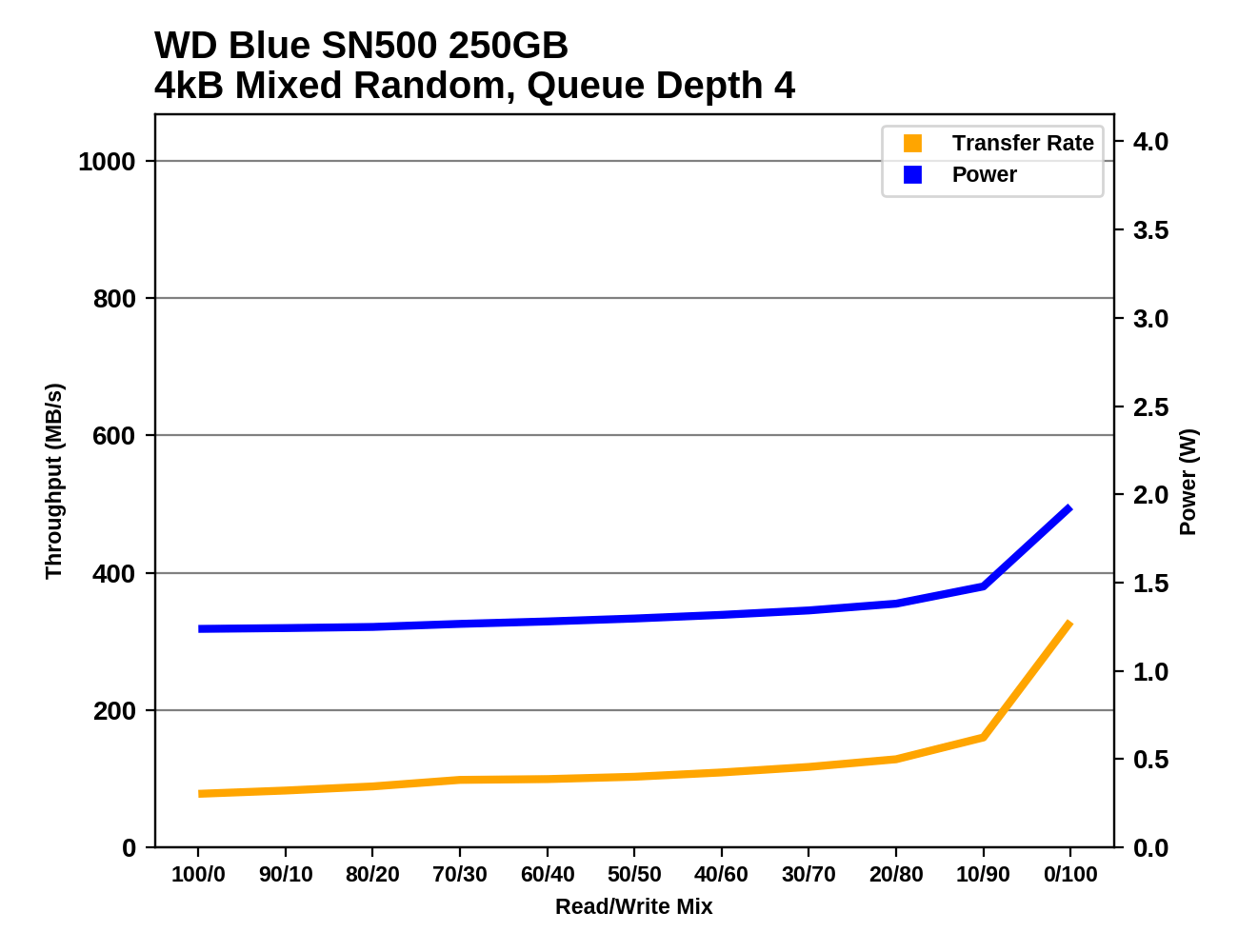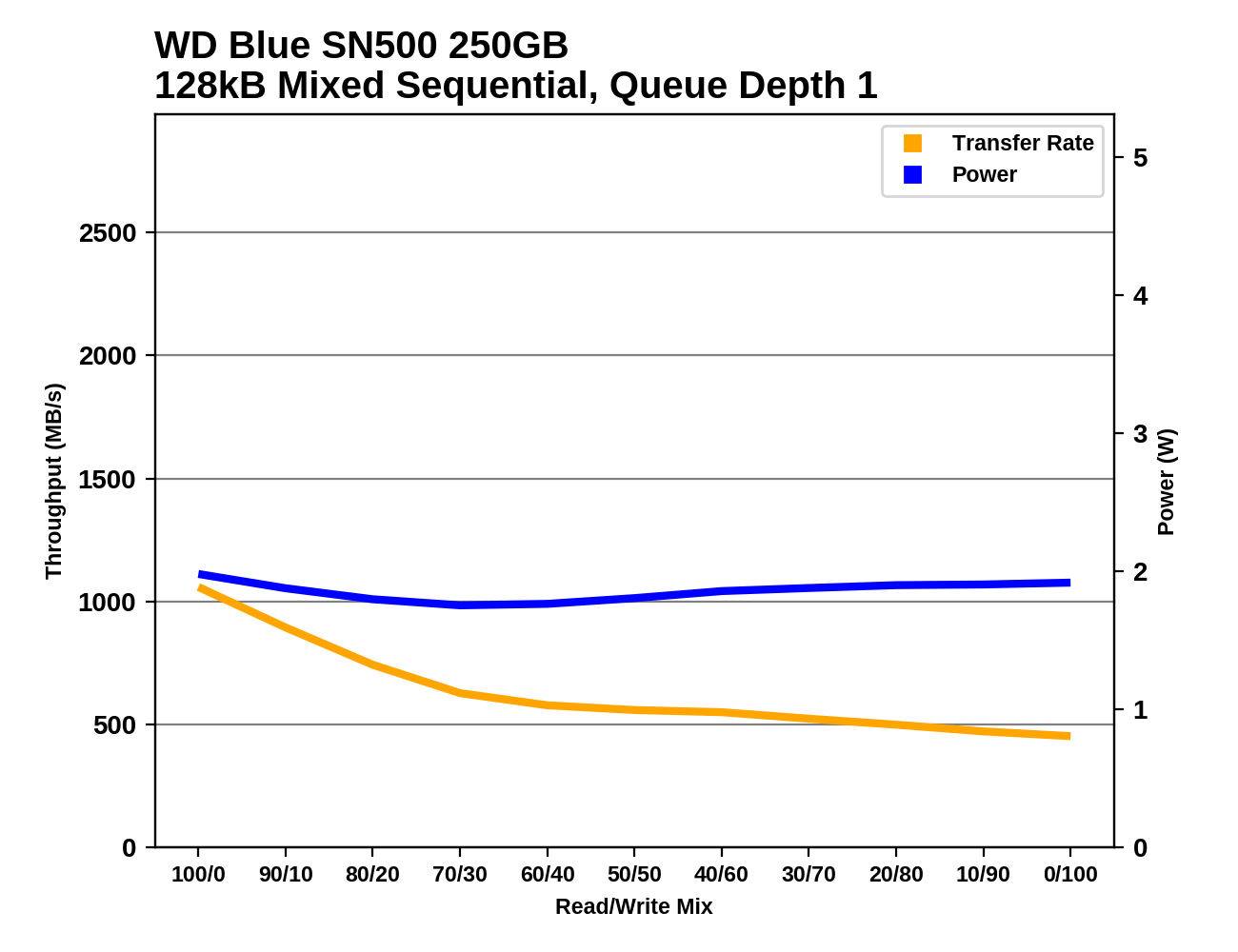The Western Digital WD Blue SN500 SSD Review: Moving The Mainstream To NVMe
by Billy Tallis on April 19, 2019 9:30 AM ESTMixed Random Performance
Our test of mixed random reads and writes covers mixes varying from pure reads to pure writes at 10% increments. Each mix is tested for up to 1 minute or 32GB of data transferred. The test is conducted with a queue depth of 4, and is limited to a 64GB span of the drive. In between each mix, the drive is given idle time of up to one minute so that the overall duty cycle is 50%.

The WD Blue SN500 is very slightly slower on the mixed 4kB random IO test than the larger WD Blue SATA SSD, and is significantly slower than the various high-end NVMe models. The other two entry-level NVMe drives are even slower than the SN500.
 |
|||||||||
| Power Efficiency in MB/s/W | Average Power in W | ||||||||
Despite relatively low performance, the WD Blue SN500's efficiency score on the mixed random IO test is a bit above average due to it drawing far less power than most of the high-end NVMe SSDs or even the SATA drives that outperformed it.
 |
|||||||||
The WD Blue SN500's performance on the mixed random IO test shows a fairly normal slow growth in performance as the workload shifts to be more write-heavy. At the very end, the ability to combine writes without any read operations getting in the way leads to a jump in performance even though the SLC write cache is full during almost all of this test.
Mixed Sequential Performance
Our test of mixed sequential reads and writes differs from the mixed random I/O test by performing 128kB sequential accesses rather than 4kB accesses at random locations, and the sequential test is conducted at queue depth 1. The range of mixes tested is the same, and the timing and limits on data transfers are also the same as above.

The WD Blue SN500 cannot compete with most of the high-end NVMe SSDs on the mixed sequential IO performance test, but it offers decent overall performance that is a bit higher than some of the other low-end NVMe drives and is a clear step up from any of the SATA drives.
 |
|||||||||
| Power Efficiency in MB/s/W | Average Power in W | ||||||||
The power efficiency of the SN500 on this test is quite a bit lower than what the 1TB WD Black SN750 delivered, but among other 256GB-class drives the SN500's efficiency is top-tier.
 |
|||||||||
As writes are added to the workload, the WD Blue SN500's performance drops—quickly at first, but then almost leveling out as the drive approaches SATA speeds. By the end of the test when the workload is pure writes, the SN500 is performing below theoretical SATA limits, but beats any actual 256GB-class SATA drive we have on hand.










50 Comments
View All Comments
gglaw - Saturday, April 20, 2019 - link
There really is no market segment for this drive unless the WD name is enough to sway a lot of customers. Pretty much every week there's an EX920 or Adata 8200 500GB drive for between $70-$80 and they are superior to this drive in every way. You could nitpick on brand reliability, etc, but both those drives have an incredible track record in the last couple years.For a primary OS/Apps drive, I would get the faster HP/Adata for a few bucks more, and for a games/storage drive I would get the cheapest SATA I could find (usually an Adata 1TB for $90). Can't think of any scenario I would get a budget NVME over one of these options. This WD drive would have to drop to $60 to be a real contender.
DyneCorp - Sunday, April 21, 2019 - link
There's absolutely a market.The SN500 will drop in price drastically. It also will stand out when prices increase, as they always do. Just as QLC dropped in price, just as 3D NAND dropped in price.
Why you people have to drop negative comments about a product that was just released, I'll never understand. It always drops in price. First world problems, my son.
By the way, spending "a few bucks more" for an overkill drive makes no sense. The SN500 is more than capable as an OS drive.
Realistically, WD releasing the SN500 provides more competition and that will lower prices. I really don't understand what your issue is.
Cisco Guy 318 - Sunday, April 21, 2019 - link
Abismal endurance! What happened to petabyte endurance? MLC is bad enough but the newer chips have poor endurance!FunBunny2 - Sunday, April 21, 2019 - link
to paraphrase an ancient consultants' adage: "speed, endurance, capacity; choose two".DyneCorp - Sunday, April 21, 2019 - link
Except that 64-layer 3D TLC NAND has exceeded planar MLC in every metric?FunBunny2 - Sunday, April 21, 2019 - link
for now, I suppose. so long as TLC is fabricated on 40-50nm, perhaps so. capitalist greed will, in due time, impel vendors to drop down to contemporary nodes in search of capacity. what then? or, is it, now?Mr Tallis: true of speed and endurance?
DyneCorp - Sunday, April 21, 2019 - link
Except that 64-layer 3D NAND (and up) from Samsung and Micron/ Intel is at 20nm and Toshiba/ Western Digital is at 19nm. You understand planar TLC basically ceased at 14-15nm?Back in 2016, with the advent of smart SLC caching techniques in addition to intelligent controller firmware, SSDs utilizing 3D NAND effectively outpaced 2D "planar" MLC. In fact, the 660p (utilizing 3D QLC) can perform on par (in certain metrics) with SSDs utilizing MLC because of Intel's intelligent pSLC caching strategies.
In the end, it doesn't matter. You'll never chew through the endurance of a modern SSD when subjecting it to consumer workloads, period. The controller can effectively mitigate write amplification in most circumstances.
DyneCorp - Sunday, April 21, 2019 - link
Abysmal endurance? Far from it. The SN500 carries an endurance rating far above the Samsung 850 EVO and is in SU800 territory; its endurance rating is actually quite high, comparatively.You do understand that just about any SSD utilizing 3D NAND has endurance ratings far beyond what 2D planar MLC SSDs had?
Most importantly, remember this: endurance doesn't matter for consumer drives. SSDs last far beyond their warranted endurance life.It's been tested.
Why is this? Because modern controllers can effectively mitigate write amplification by several factors. The majority of consumer workloads will NEVER burn through rated endurance, period. Honestly, including a TBW rating is unnecessary.
PeachNCream - Monday, April 22, 2019 - link
You can expend the write endurance of a modern SSD. It isn't a difficult prospect and workloads don't have to be heavy ones for that to happen.DyneCorp - Monday, April 22, 2019 - link
Under consumer workloads (OS and gaming) no, you cannot. It has been tested. Also, SSDs regularly outlast their given TBW rating by multiple times. If you check the S.M.A.R.T. attributes and software of older planar SSDs you'll see that even heavily utilized SSDs are healthy.